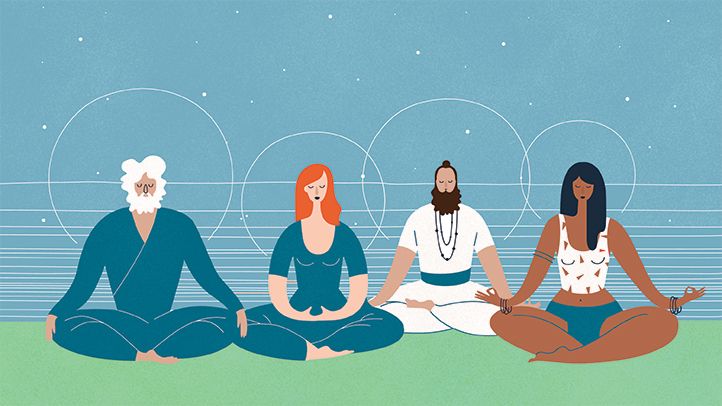Yoga is a practice that has been around for thousands of years. It encompasses physical postures, breathing exercises, and meditation or relaxation. Do yoga. It is good for your body and mind. You will have less stress, lower blood pressure, and more energy. The poses in yoga are designed to stretch muscles, increase flexibility and strengthen the core. Yoga therapy has many benefits. It makes you happy, less anxious, and better able to focus on the tasks at hand.
Contents
What is Yoga Therapy?

Yoga therapy is a holistic approach to health and wellness that applies the principles of yoga. Yoga therapists want to heal you. They use exercises, breathing, and meditation to do this. They also use yoga postures or stretches. Yoga therapy can help people with a wide range of health conditions.
Benefits Of Yoga Therapy
Physical Benefits

Yoga helps to stretch and tone the body. It also increases flexibility and strength. Yoga is great for runners because it strengthens the core muscles. These are the muscles that support the spine and keep you upright. Yoga also helps to improve balance and coordination. Yoga is helpful for people with health problems who want to lose weight. It can help them build muscle and increase their metabolism so they burn more calories. Yoga might also be good for pregnant women because it helps the body adjust gradually during pregnancy and recover easier after birth.
Yoga can heal your body when you have headaches, back pain, heart disease, and cancer recovery. People recovering from a stroke or brain injury may benefit as well. If you have any of these conditions yoga could help heal your mind and body!
Mental Benefits

Yogis believe in a balance between the three parts of your being – ātma (soul), buddhi (intellect), and Citta (emotions and feelings). When these three work together in harmony, you have good mental health. Yoga therapy can help to restore balance within the body and mind.
Mental Wellness And Happiness

Yoga therapy benefits people mentally in many ways! It helps to reduce symptoms of mental illness like ADHD (attention-deficit/hyperactivity disorder), autism spectrum disorders, schizophrenia, OCD (obsessive-compulsive disorder), PTSD (post-traumatic stress disorder), bipolar disorder, and more! People with chronic conditions including arthritis pain, diabetes mellitus, lupus erythematosus, multiple sclerosis, fibromyalgia, cancer recovery – all these types of diseases may benefit from yoga therapy since it is a holistic approach to health focusing on body, mind, and spirit.
There are many benefits to yoga therapy! It helps with physical problems, mental issues, and creates balance within your being. Yoga is a great way to improve overall health and well-being. Give it a try today! You will not regret it! 🙂
Types Of Yoga Therapy

There are many different types of yoga therapy. Below are a few of the most common:
- Hatha Yoga: Hatha yoga is a gentle form of yoga that is good for beginners. It focuses on stretching and strengthening the body.
- Iyengar Yoga: Iyengar yoga is a type of hatha yoga that uses props such as blocks, straps, and chairs to help people achieve proper alignment in poses. This type of yoga is good for people with injuries or who are not flexible.
- Ashtanga Yoga: Ashtanga yoga is a fast-paced style of hatha yoga that incorporates breath work and Vinyasa flow sequences. This type of yoga is good for people who want to build strength and flexibility.
- Bikram Yoga: Bikram yoga is a hot style of hatha yoga that uses 26 poses and takes place in rooms heated to 105 degrees Fahrenheit with 40% humidity. If you are looking for an intense workout, this could be the right type of yoga for you!
- Restorative yoga focuses on relaxing your mind and body through gentle stretches and longer holds in postures. This style of yoga means that your muscles can relax. They don’t have to work as hard as other styles, like Ashtanga or Vinyasa flow. The heat from restorative yoga can help open up tight joints and provide pain relief
Restorative yoga also incorporates meditation. This type of exercise can help you quiet the mind and overcome stress, anxiety, depression, or addiction.
How effective is yoga therapy?
The effectiveness of yoga therapy depends on the person. Some people see results immediately, while others may need to practice for a longer period before they start to see changes. Yoga is a personal journey that requires dedication and commitment to reap the full benefits.
Yoga therapy can positively affect self-esteem, social anxiety, and improving mood. It helps people to treat addiction by making them feel happier and healthier in their skin which helps with recovery.
How can we begin Yoga Therapy?
There are many different ways to begin yoga therapy. If you have never done yoga before, I would recommend starting with a Hatha or Iyengar class at a local studio. Ashtanga and Bikram are more intense styles of yoga and maybe too much for beginners. If you have some experience with yoga, try a vinyasa flow or restorative class.
Whichever style of yoga you choose, make sure the instructor is certified and has experience teaching people with mental health conditions. There are also online classes that can be found on websites like YogMantra or Gaia. These classes offer a variety of lengths, levels, and styles so that everyone can find the right one for them!
If you’re not sure if yoga is for you, or you’re not sure where to start, I would recommend reading this post about the different types of yoga. Once you have a better understanding of the different types of yoga, it will be easier to find the right class for you!
What diseases can be cured with Yoga Therapy?

Many different conditions can be improved with yoga therapy. The research on this type of treatment is still being done, but there have been good results.
Yoga has helped people with depression, anxiety, addiction (including alcoholism and drug abuse), ADHD/ADD, insomnia, arthritis pain management, menstrual cramps relief, back pain reduction, high blood pressure, heart problems such as coronary artery disease & congestive heart failure.
It helps people who have PTSD feel better after they have had something terrible happen. It can help them to sleep better at night, or to not have bad dreams.
Limitations
Every person is different and will respond differently to yoga therapy. What works for one person may not work for another. It is important to consult with a yoga therapist before starting any new program to ensure that it is safe and appropriate for you!
It’s also important to note that yoga should never be used as a replacement for medical treatment. If you are experiencing any physical or mental health problems, please consult with a healthcare professional.
Role Of A Yoga Therapist

A yoga therapist’s role is to help people who are looking to improve their mental and physical health through the practice of yoga. They work with individuals one-on-one or in groups to create a personalized program that meets the person’s needs.
The yoga therapist will assess the person’s condition, abilities, and goals before creating a plan. This plan may include asana (poses), pranayama (breathwork), meditation, or relaxation techniques.
The therapist will also guide how often to practice, what type of yoga is best for them, and how to modify poses if needed. They might also suggest that a person works with a yoga instructor or class if they need more support.
A yoga instructor teaches people how to do poses, breathing techniques, and meditation practices. This helps them get the most out of their classes. They guide students through the physical postures while helping them find inner peace and awareness in each moment.
Instructors need to have personal experience practicing yogic philosophy because it helps them connect better with their students on an emotional level! Yoga instructors must be certified by taking training courses from accredited institutions like American Council on Exercise (ACE) or National Association for Fitness Certification (NAFC). Instructors who are registered/licensed may provide additional training and education.
How Yoga Therapy Can Help People?

Yoga therapy is a non-invasive form of treatment that has been shown to improve the mental and physical well-being of people who practice it regularly! It helps with stress, anxiety & depression by calming our nervous system which reduces cortisol levels (stress hormone). Regular yoga also makes you feel better. It increases serotonin production, helps with insomnia, and improves your heart. It’s good for pain too. One study found that individuals with bipolar disorder had fewer mood swings when they practiced Yama and niyama instead of taking medication alone.
Many different types of yoga offer good things for people who have arthritis. Yoga can help to stretch your muscles and increase blood flow for joints, so they get more oxygen. Yoga also helps to increase range of motion and improve balance, which can be difficult when you’re experiencing arthritis pain.
One study found that people with asthma who practiced yoga had better lungs and fewer symptoms.
Studies have shown that cancer survivors who practice yoga have a better quality of life after treatment! They experience less fatigue, insomnia, anxiety & depression. Yoga therapy has been proven to help reduce stress levels and promote relaxation.
PTSD is a mental health condition that can develop after someone experiences or witnesses a traumatic event. Symptoms can include flashbacks, nightmares, severe anxiety, and uncontrollable thoughts about the event. There is still much research needed on the effects of yoga on PTSD. Some studies show it can help reduce symptoms.
One study found that veterans who practice yoga have less PTSD. PTSD is when people have nightmares and bad dreams. They might not sleep well too. The participants also reported an increase in energy levels and better sleep quality.
Conclusion
Yoga therapy is a form of physical activity that can be practiced by people with or without injuries. It has been shown to reduce stress and anxiety, improve mood, promote balance in the body and mind, increase flexibility and strength, and induce relaxation. There are many different styles of yoga available for anyone who wants to try it out. The practitioner should find one that suits their needs best. If you want to try this but don’t know where to start, search on the internet for beginner videos about how to do specific poses before taking a class in person.
If you are looking for affordable Online Counseling MantraCare can help: Book a trial therapy session


